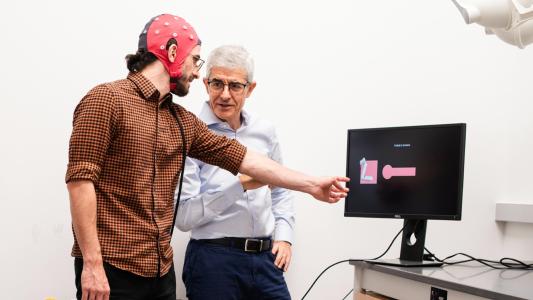A medication used to treat diabetes appeared to halt the progression of Parkinson’s symptoms in a phase 2 trial of people in the early stages of the disease. While more research is needed to see how large the effect is and how long it might last, the news is encouraging in the hunt for new Parkinson’s treatments.
The challenge: More than 8.5 million people worldwide are living with Parkinson’s, a progressive neurodegenerative disease caused by the loss of brain cells that produce dopamine, which helps neurons communicate.
Common Parkinson’s symptoms include tremors, stiffness, and impaired cognition. Meds that replace dopamine can help alleviate those, but they don’t address the underlying cause — the loss of dopamine neurons — and so the disease progresses.
“This is the first large-scale, multicentre clinical trial to provide the signs of efficacy that have been sought for so many years.”
Olivier Rascol
The connection: Though we don’t fully understand it, there appears to be some link between Parkinson’s and diabetes — research suggests that people with diabetes are 40% more likely to develop Parkinson’s and that their symptoms tend to progress more rapidly than in non-diabetics.
A few studies in animals and people have also found that GLP-1 agonists — a class of drugs used to treat diabetes and, more recently, obesity — might be able to slow Parkinson’s symptoms, but they were too small to be conclusive.
What’s new? French researchers have now published the results of a phase 2 trial in which people treated with the GLP-1 agonist lixisenatide experienced no progression in their Parkinson’s motor symptoms over one year.
Participants given a placebo, meanwhile, experienced a slight worsening of symptoms by the end of the 12 months.
“This is the first large-scale, multicentre clinical trial to provide the signs of efficacy that have been sought for so many years,” said co-lead researcher Olivier Rascol from Toulouse University Hospital.
The trial: The trial enrolled 156 people between the ages of 40 and 76 in the early stages of Parkinson’s. All of the participants had been taking a dopamine-replacement medication for at least one month.
At the start of the trial, each volunteer completed a survey to determine the severity of their motor disability on a scale of 0 to 132, with a higher score indicating more disability. They were then split into two equal groups, with both groups having an average score of approximately 15.
Scores in the placebo group increased by about 3 points, while those in the treatment group stay about the same.
For one year, people in one group received daily injections of lixisenatide, while those in the other group injected a placebo. All of the participants continued to take their standard Parkinson’s medications.
At the end of the year, the survey scores in the lixisenatide group were .04 points lower, indicating essentially no change. The scores in the placebo group increased by about 3 points, indicating a worsening of symptoms.
The volunteers then stopped taking any medications for Parkinson’s for two months and completed the survey again.
This time, the average scores ended up at 17.7 in the treatment group and 20.6 in the placebo group — both experienced worse symptoms off their meds, but the gap between them remained the same. The researchers say this suggests that the GLP-1 treatment wasn’t just masking their Parkinson’s symptoms while they were taking it, but may have actually prevented the loss of dopamine neurons.
Side effects were common in the treatment group, with 46% experiencing nausea and 13% vomiting, but lixisenatide is a relatively old GLP-1 agonist, and neurologist David Standaert, who was not involved in the trial, told Nature that newer options might be more tolerable.
“What would happen if the patients would take this drug for two years or three years or five years?”
Wassilios Meissner
The big picture: Though the trial results are encouraging, there’s still a lot we don’t know about the effect of GLP-1 agonists in people with Parkinson’s, including whether the meds can affect symptoms that aren’t related to movement, such as impaired cognition.
People with Parkinson’s usually live 10 to 20 years after diagnosis, too, so figuring out whether lixisenatide or another GLP-1 agonist can halt or slow the progression of any Parkinson’s symptoms over a longer period of time is hugely important.
“[T]he question now would be what would happen if the patients would take this drug for two years or three years or five years? Would there be an additional effect?” co-lead researcher Wassilios Meissner told STAT. “That is something future trials definitely need to address.”
We’d love to hear from you! If you have a comment about this article or if you have a tip for a future Freethink story, please email us at [email protected].






